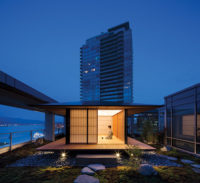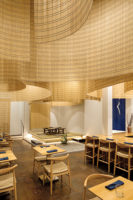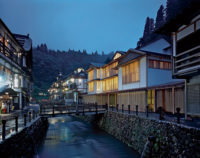Located on the campus of Switzerland’s École Polytechnique Fédérale de Lausanne (EPFL), Kengo Kuma’s ArtLab is an elegant, low sliver of a building, overlooking Lake Geneva and the Alps beyond. Making a strong urban as well as architectural statement, its linear form slices across the landscape, asserting the humanities’ newfound role at this historically technical university.
ArtLab is the latest addition to the school’s growing collection of high-profile buildings—SANAA’s Rolex Learning Center (RECORD, June 2010, page 156) and Dominique Perrault’s New Mechanics Hall (2016) are both nearby. This project began with an international competition held in 2012. The brief called for three pavilions, containing a café, an art gallery, and an exhibition space. Taking a gamble, Kuma proposed a single, 33,000-square-foot structure instead. This strategy not only combined all three components under one roof, it also helped organize the school’s chaotic campus. “There are many interesting buildings here, but they had no order,” the architect says.
Additional Content:
Jump to credits & specifications
ArtLab’s impact is disproportionate to the size of its footprint. It clearly demarcates the edge of the Place Cosandey, an open plaza abutting the SANAA and Perrault buildings, and establishes a north–south axis linking the student dorms and the Esplanade Piazza, the school’s social hub north of the new building. In addition, ArtLab’s slender proportions—it measures just 20 feet across at the north end and 52 feet at the south—and the stepped east elevation gently guide the eye toward the shimmering gray lake and the majestic mountains in the background.
Unlike EPFL’s typically boxlike multifloor buildings, ArtLab’s three programmatic pieces are independent and clearly articulated. From the building’s north end, the sequence starts with the DataSquare, an interactive display hall for EPFL-created projects; goes on to the Art & Science Pavilion, an experimental exhibition space; and ends with the Montreaux Jazz Café, which serves up the famous music festival’s archived collection (it was digitized by EPFL), alongside student-friendly cuisine. In between each discrete space or volume, covered porches facilitate circulation into and around ArtLab. In addition to accommodating individual entry vestibules for the programmed spaces, the porches open to the perpendicular streets that cross the site in two places, allowing people and vehicles to pass right through the building.
Uniting these components is a prominent 820-foot long roof. “I wanted one strong identity, an umbrella for all those elements,” explains Kuma. It is made with folded planes that adjust as the building widens, with the ridgeline shifting and the eaves rising up or touching the ground dramatically at either end. “We did not want the building to simply stop like a cut baguette,” explains Javier Villar Ruiz, Kuma’s partner in charge. Along ArtLab’s west elevation, the roof quietly bends over and hugs the wall, but on the east elevation it terminates in generous eaves, creating a covered walkway. Shielding students from Lausanne’s frequent rains, it evokes the Japanese engawa (porch), a favorite Kuma motif. Though bold and sculptural, the roof’s shape resulted from a mixture of internal and external conditions, including a 15-foot-high wall for the exhibition space, truck clearances, and access for emergency vehicles. Square slate shingles, imported from Spain, are the roof’s cladding, a polite nod to the Swiss vernacular. Resembling fish scales, the stone plates, installed on a 45- degree angle, adjust to the roof’s changing geometry.
Fifty-seven prefabricated frames, spaced 12 feet apart along the length of the building, hold up the roof. Composed of columns and beams measuring 5 inches wide and 2 feet deep, each frame is the same in section but differs in height and span due to the roof’s irregularities. All are made of spruce sandwiched between perforated steel plates secured with transparent glue. Lightening the metal’s hard surface both literally and figuratively, the round cutouts allow dots of warm wood grain to show through. Within the frames’ standardized width, the ratio of metal to wood varies invisibly, enabling the use of additional steel where needed. “We can change the proportions like a cocktail’s,” jokes Ruiz.
The frames, which straddle the exterior walls of 2-inch-thick glass sheets and gray spruce panels, also secure them. The spruce, pre-aged to prevent uneven coloration, is also used for the eaves’ soffits, which continue inside for the ceilings. Since the wood does not conduct heat, Kuma could use the same material inside and out without incurring the heat loss that happens with metal. The architects, who were responsible for the interior design (except for the café), selected minimal finishes such as white gypsum board and polished concrete flooring.
Unlike Kuma’s approach in many other buildings, delicate detailing and decorative surfaces are conspicuously absent. This time, Kuma was after something different: dramatic and daring, his ArtLab makes its mark with one bold sweep.
The exposed structure becomes its own ornament, and its rational construction methodology becomes an educational tool, as befits a school known for nurturing the next engineers. True to its name, ArtLab is a place for art as well as a lab for learning.
CreditsArchitect: KENGO KUMA & ASSOCIATES
Personnel in architect's firm who should receive special credit: Lead Architect : Kengo Kuma & Associates; Javier Villar Ruiz (Partner in charge - reg. arch.) with: Nicola Maniero (reg. arch.), Rita Topa, Marc Moukarzel, Jaeyung Joo, Cristina Gimenez (reg. arch.)
Associate architect(s): Local Architect: CCHE Lausanne
Engineers Lighting Design : L’Observatoire Internationale
General contractor: Marti Construction SA, Lausanne
Photographer: Michel Denancé, Valentin Jeck, Joel Tettamanti, Adrien Barakat _ DMK photography |
SpecificationsStructural System Main structure is composed by a sandwich of steel and wood Manufacturer of any structural components unique to this project: In order to frame and protect the view of the lake from the existing Esplanade plaza, the building remains very thin in its northern end, about 5m, and its sections widens up to 16m on its southern end. To solve structurally such an exaggerated slender building that always changes in width, we developed a new kind of structure solution combining wood and steel. Changing the proportion of the wood/steel composition allowed to have all the 57 structure portals (that are all different in span) to have the exact same section throughout the building, making the whole envelope of the project modular and able to be prefabricated. Exterior Cladding Wood: extrerior wall :preaged wood (larch) Other cladding unique to this project: The building’s eaves provide shelter for those walking along the piazza between the Esplanade, heart of the campus, and the student housing in the South. Due to those eaves protecting the upper side of the façade, its wooden cladding would age in a heterogeneous way throughout the surface; therefore the wood was pre-aged in order to achieve a stable presence during its life span. Local larch was chosen for the façade as it has good endurance based on local practice. The light gray tone of the pre-aged wood cladding, together with the dark grey slate roofing, give a rather quiet and subtle presence to the building, despite its remarkable length. These cold grayish tones dialogue with those of other buildings surrounding the piazza and as well with the generally overcast weather of Lausanne. It is only when one gets closer to the building, receiving shelter by its roof, that we discover the warmth of its vast wooden ceiling. Roofing Built-up roofing: roof : Ardoise/Slate stone (stone is from Spain)
Windows Metal frame: Windows frame and glazing by Fahrni Fassadensysteme AG
Glazing Glass: Windows frame and glazing by Fahrni Fassadensysteme AG
Doors Entrances: Main entrance glass doors by Fahrni Fassadensysteme AG
Interior Finishes Special interior finishes unique to this project: Mostly of the material which have been used for the interior are quite standards: Furnishings Reception furniture: White metal custom made Reception desk at the museum and at school the exhibition apavilion
Lighting Interior ambient lighting: The lighting system for the museum has been studied together with L'observatoire International. Spot lights are placed on the railing in between the ceiling panels and additional wash-wall light gives the correct amount of lights for the museum. |
















Post a comment to this article
Report Abusive Comment